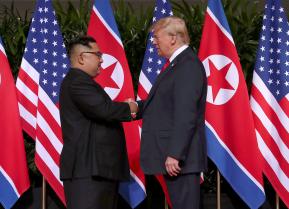Explained: Why North Korea's Voluntary ICBM Test-Ban Is a Big Deal
"This represents a big change," Wright continued. "In the five years 2013 to 2017, North Korea launched more than 80 flight tests of 10 different missiles, or an average of 16 flight tests per year. In 2017 alone, it launched 20 tests of seven types of missiles, including the successful launch of two different long-range missiles."
U.S. president Donald Trump and North Korean leader Kim Jong Un planned to meet in Hanoi in late February 2019 to discuss nuclear weapons.
The summit comes eight months after Trump and Kim's first summit, in Singapore. While North Korea has not signaled it will give up its roughly 50 nuclear warheads nor dismantle the medium- and long-range missiles that can carry the warheads, Kim's regime has made at least one major conciliatory gesture.
It stopped testing nukes and medium- and long-range missiles. The testing halt offers some hope that Trump and Kim can come to a meaningful agreement that at least reduces the nuclear threat from North Korea.
David Wright, the co-director of the Union of Concerned Scientists' Global Security Program in Massachusetts, in a February 2019 explainer neatly summarizes the test-halt and its implications.
"In April 2018, shortly before last June’s summit with President Trump, North Korea announced it was discontinuing its flight testing of ballistic missiles," Wright wrote. "For over a year now, it has not conducted any missile tests."
"This represents a big change," Wright continued. "In the five years 2013 to 2017, North Korea launched more than 80 flight tests of 10 different missiles, or an average of 16 flight tests per year. In 2017 alone, it launched 20 tests of seven types of missiles, including the successful launch of two different long-range missiles."
Countries typically test a new missile dozens of times before deploying it. Even though North Korea had one successful launch of its Hwasong-15 ICBM in late 2017, it has little idea whether a second test would be successful. These are very complicated mechanical systems and you need repeated testing to discover the possible failure modes and understand their probabilities.
For a missile to be militarily useful, you want to know how reliable it is. And you want to understand how likely it is to blow up on the launch pad before you decide to put a nuclear warhead on it.
In addition to this, North Korea hasn’t demonstrated a working reentry heat shield on a long-range trajectory. As long as it’s willing to accept low accuracy—which it would be if it plans to target large cities—developing a working heat shield doesn’t require advanced technology.
North Korea should be able to solve this problem with time, but it is unlikely to consider these missiles militarily useful without actually demonstrating the technology on a flight test. A ban on testing keeps it from doing that.
While some press reports have said that following its one successful flight test of its Hwasong-15 ICBM, North Korea is working to mass produce it, I don’t believe they would do that. Preventing further flight tests would prevent this missile from becoming militarily useful. It would also limit operational training of military troops with its missiles.
So preserving North Korea’s ban on flight tests is an important security measure.
At their summit in Hanoi, Trump and Kim should formalize the voluntary test-ban and extend it to cover shorter-range missiles, Wright advised.
"The United States should also press for a ban on engine tests, and make clear the flight test ban includes satellite launches," Wright added.
North Korea has not yet taken irreversible steps toward ending its missile program. But it has taken meaningful steps that would have been unthinkable as recently as 2017, and that suggests an openness to further steps that would be more meaningful. That would significantly advance security interests of the United States and its allies in the region.
Achieving these steps is likely to require a phased step-by-step process. There are a set of potential steps the United States could take as part of the negotiations. These include discussions of a peace treaty or new security arrangement in the region, scaling back military exercises that the North sees as threatening, and selective easing of sanctions.
A verified ban on flight testing, of course, is just a step. The ultimate goal should be to stop further missile development and production at all levels, and to eliminate existing missiles—and that is what the United States should be working for.
But that will require North Korea to feel secure enough to agree to these steps, which would include intrusive verification measures. That is not going to happen overnight and will require reciprocal steps by the United States.
David Axe serves as Defense Editor of the National Interest. He is the author of the graphic novels War Fix, War Is Boring and Machete Squad.
Picture: Reuters.


